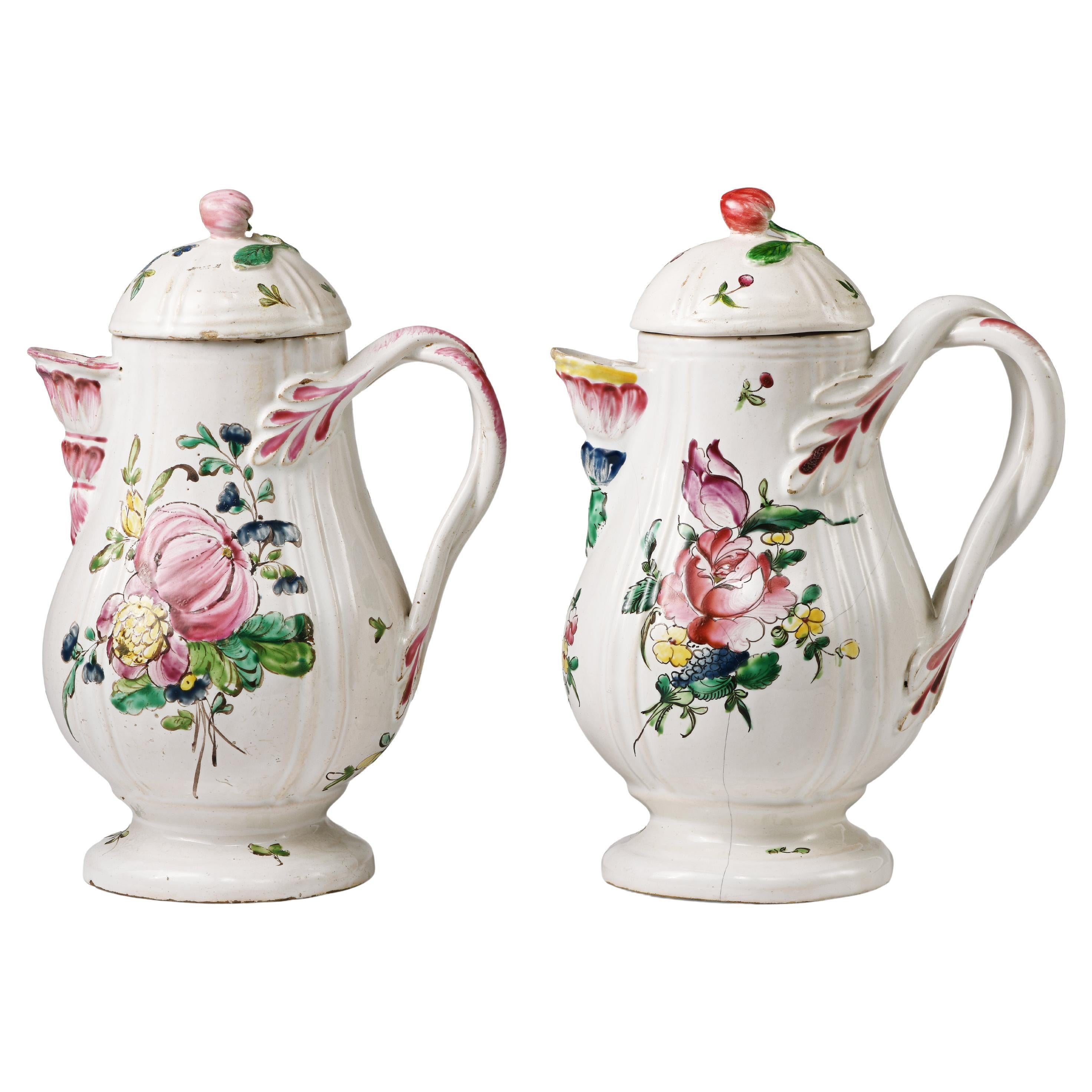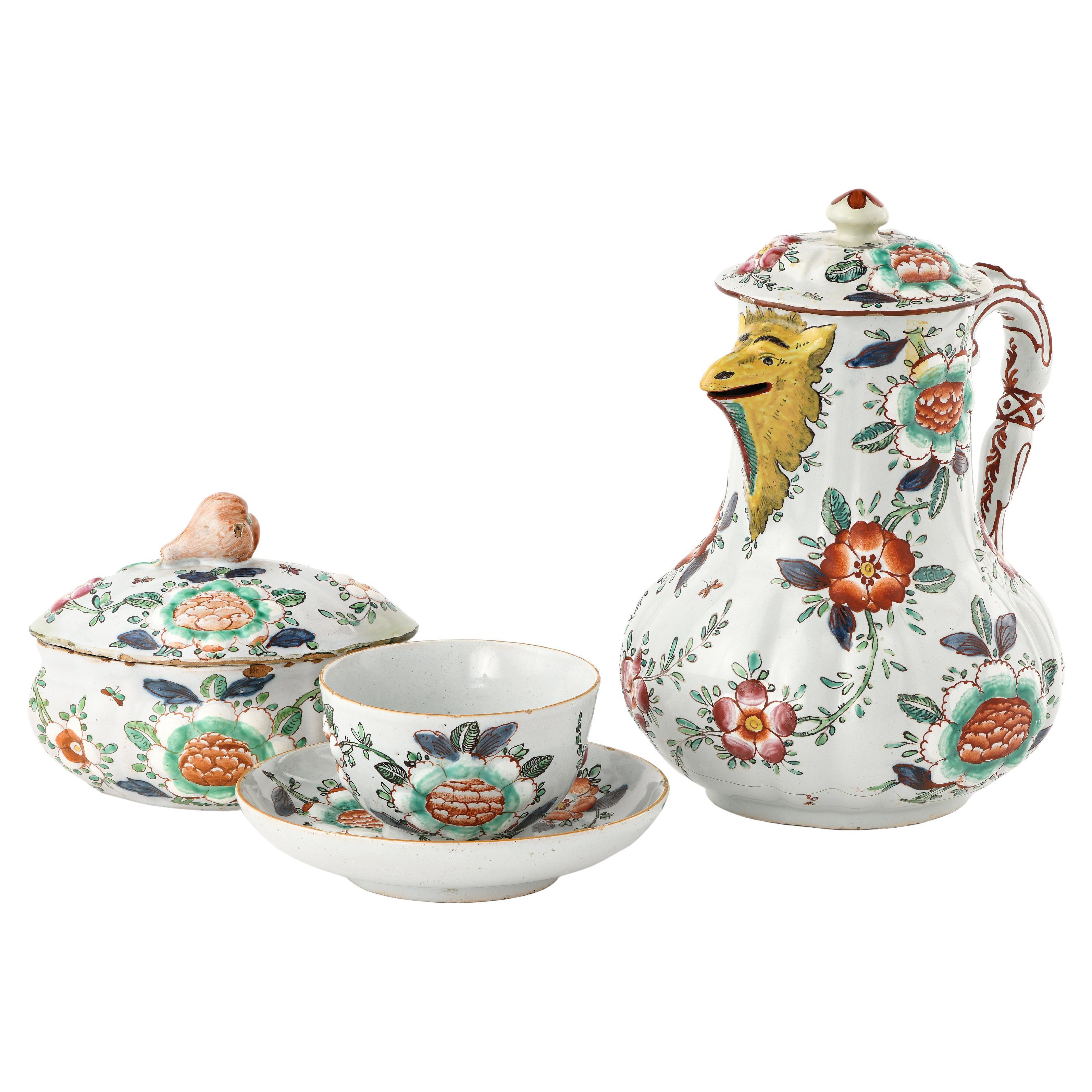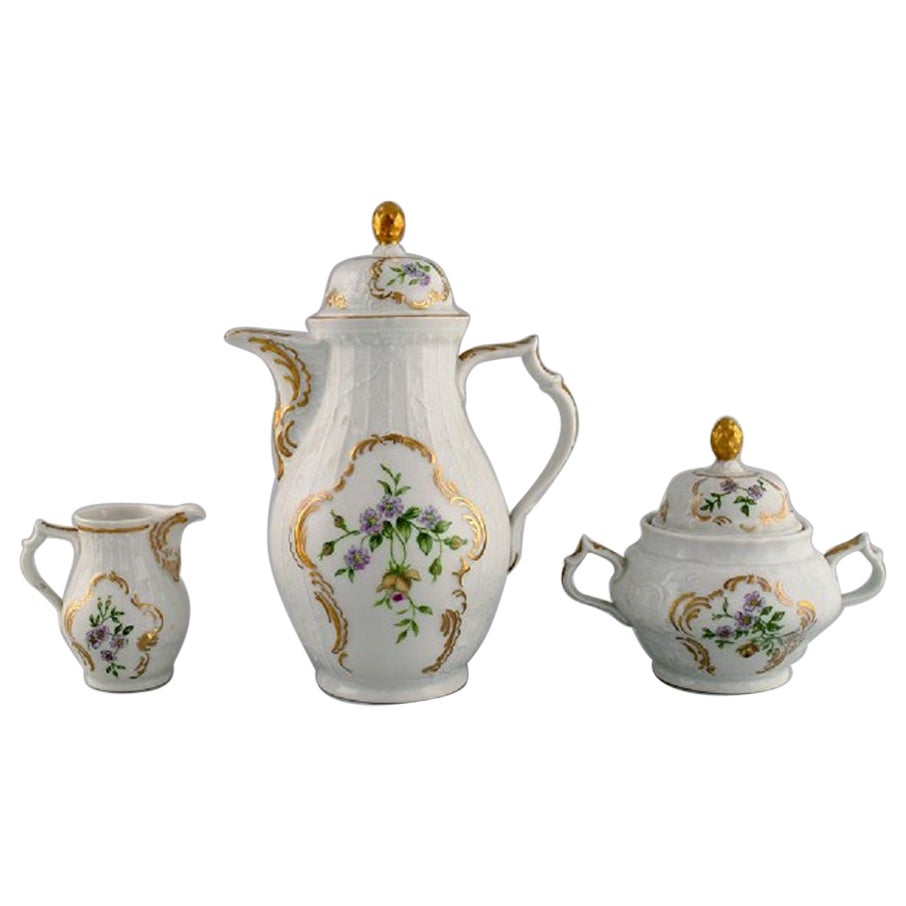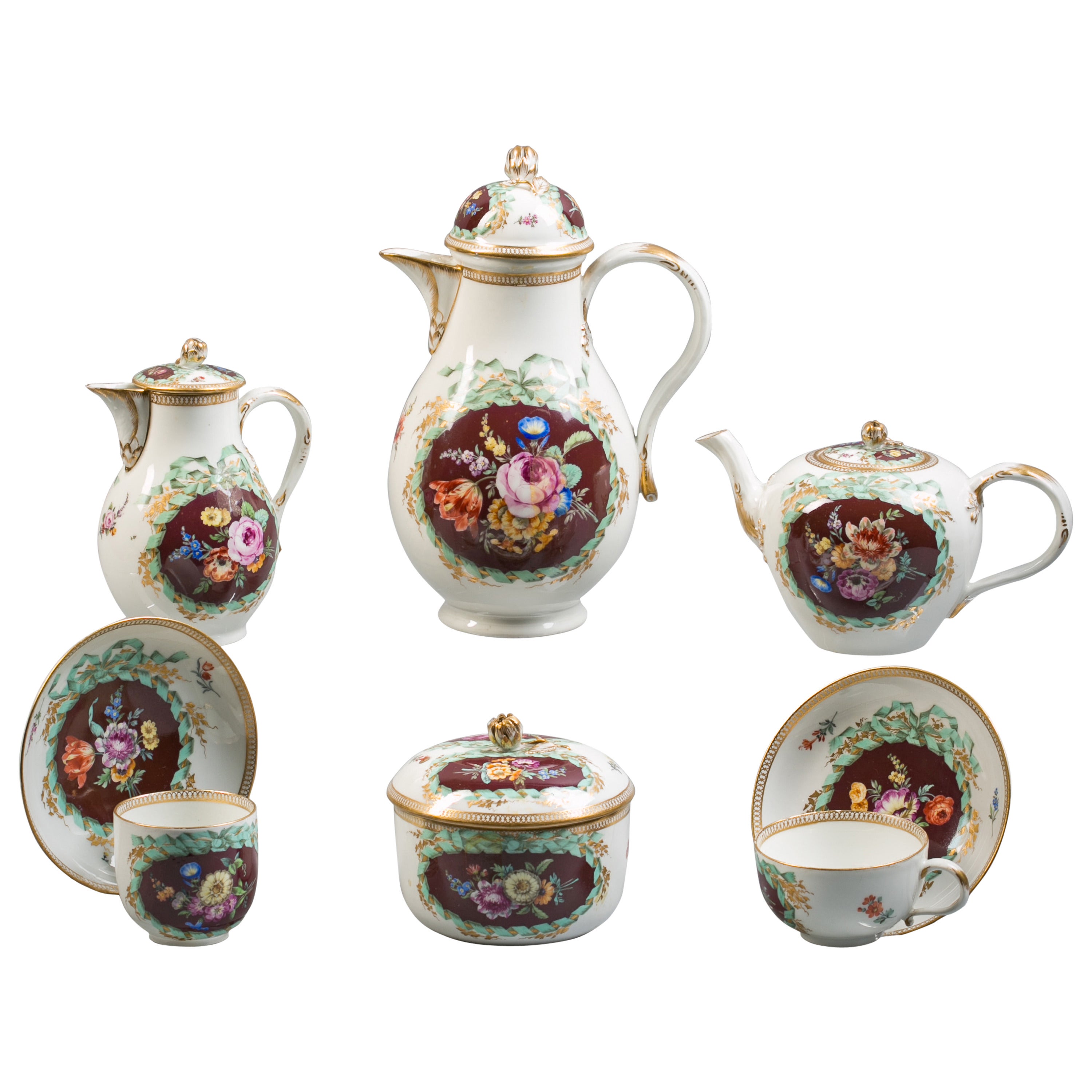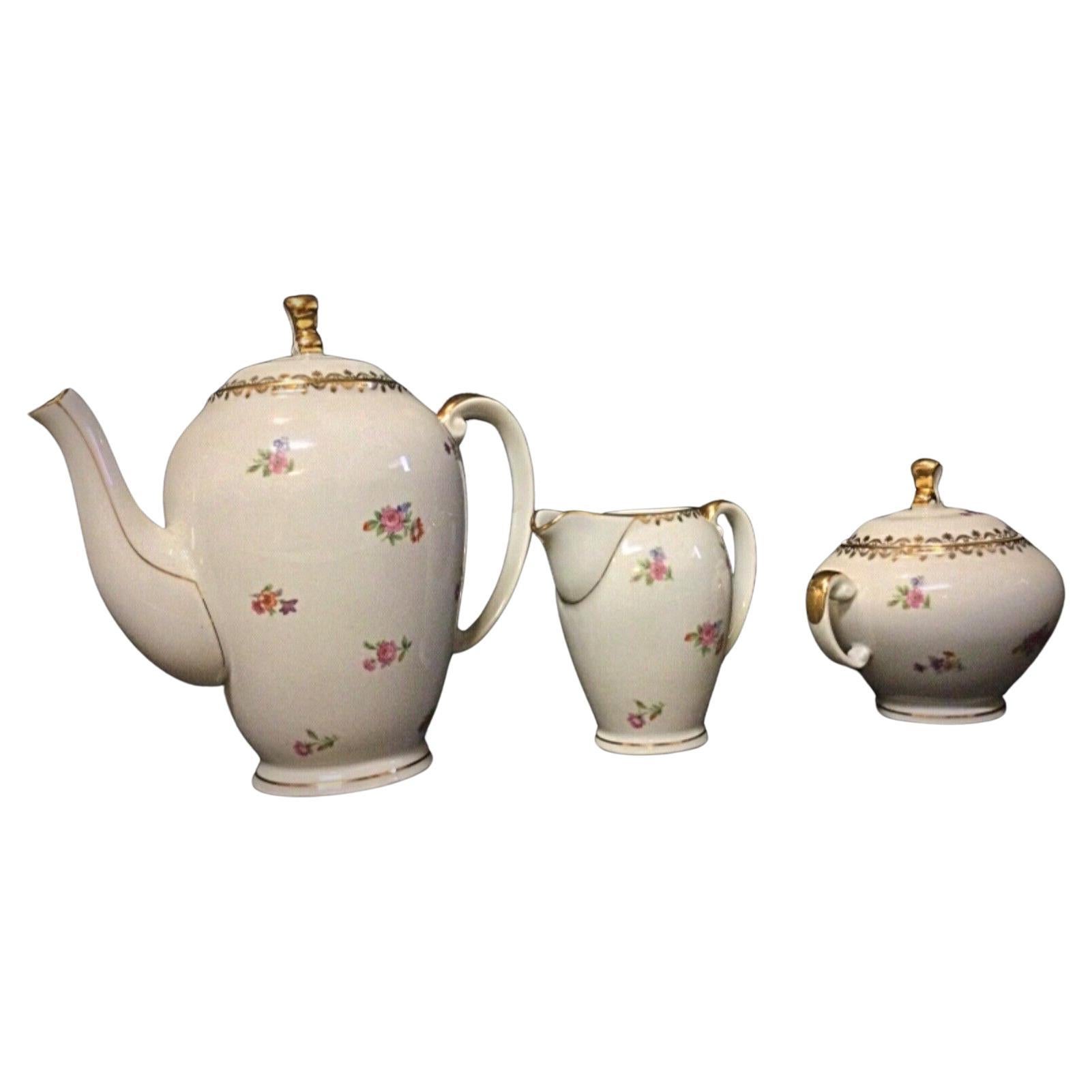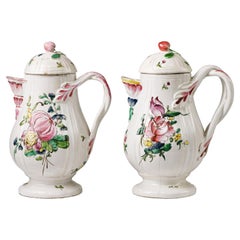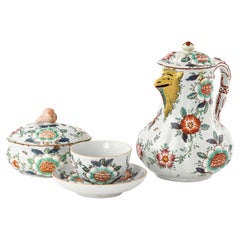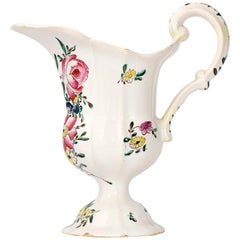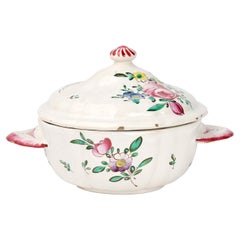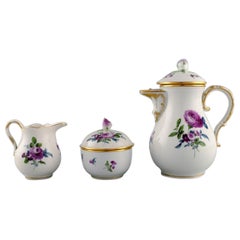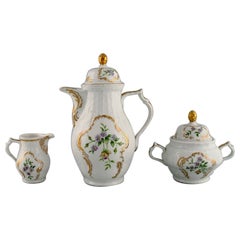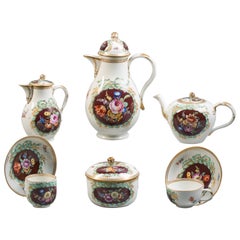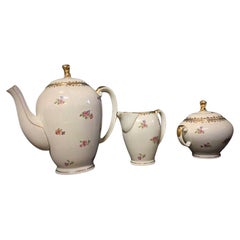Items Similar to Ancient Italian Assortment Coffe Pot and Cups, Lodi, Circa 1765-1770
Video Loading
Want more images or videos?
Request additional images or videos from the seller
1 of 20
Ancient Italian Assortment Coffe Pot and Cups, Lodi, Circa 1765-1770
$7,095.22per set
£5,393.56per set
€6,000per set
CA$9,971.27per set
A$10,842.34per set
CHF 5,712.85per set
MX$131,702.97per set
NOK 71,822.12per set
SEK 67,327.44per set
DKK 45,925.26per set
About the Item
A coffee pot and two cups with saucers
Antonio Ferretti Manufacture
Lodi, Circa 1765-1770
Maiolica polychrome decorated “a piccolo fuoco” (third fire).
They measure:
coffee pot: 9.64 in height x 6.69 x 5.51 (24.5 cm x 17 x 14); ); 1.16 lb (528 g)
cups:
a) 2.75 in height (7 cm); saucer diameter 4.33 in (11 cm); 0,357 lb (162 g)
b) 2.75 in height (7 cm); saucer diameter 4.33 in (11 cm); 0,372 lb (169 g)
State of conservation: the cups are intact. The coffee pot is intact except for a marked chip on the foot in the back and two chips on the edge of the lid, which also has a glued grip without touch-ups to the paint. Slight chipping from use to the internal stop circle of the lid.
The coffeepot, with a ribbed, enlarged and bellied pyriform body, rests on a slightly everted flat foot and has a rather pronounced beaked pourer. The upper portion of the handle is curved in a C-shape whereas the lower portion is another C-shape curving in the opposite direction. The coffee pot has a raised and cusped lid surmounted by a tall and slightly twisted knob.
The polychrome decoration, carried out “a piccolo fuoco” (third fire), shows, on the front under the spout, a composite bouquet of flowers with small rosettes and spring flowers from which some thin stems branch off supporting minute buds. Some scattered florets and secondary bouquets scattered along the body and on the lid complete the decoration. The handle is lined with purple, while the rim, the lid knob and the spout are highlighted with a touch of gold. Under the foot there is a dark green brushstroke - “chiodo”(nail) - to indicate the decoration to be created in the process.
The coffee pot is a rather rare and typical example of high “a piccolo fuoco” (third fire) production, of which few known examples of comparison have been made (M. L. Gelmini, in Maioliche lodigiane del '700, cat. mostra Lodi, Milano 1995 p. 147 n. 56 without lid; the shape is perfectly comparable to the specimen decorated in green monochrome on p. 187 n. 226).
The cups have a slightly ribbed circular body and a slightly raised disc foot, with a tubular handle woven like a branch. The saucer is circular, with a smooth edge and a disc-shaped foot with a vertical brim. The rim of both cups and plates is highlighted with gold. The decoration known as “a fiori fini“ shows on the front of the cup a) a bunch of flowers, with the rose and various flowers as well as some flowering branches repeated, in a more contained and decentralized version, on the saucer. On the second cup b) the decoration is distinguished by the presence of a multi-petal flower, probably a marigold or a marzolino flower, and small florets. This decoration with small flowers, painted with great skill in the Ferretti factory, constitutes, along with the other rare examples of comparison (M. L. Gelmini, Maioliche lodigiane del ‘700, Milano 1995, p. 146 nn. 154-155), a poignant example of the high production level achieved, in some ways comparable to German porcelain models.
This decorative style represented a strong point of the Lodi factory, which established itself thanks to the vivid nature of the colors made possible by the introduction of a new technique perfected by Paul Hannong in Strasbourg and later introduced by Antonio Ferretti to Italy. The production process, called “piccolo fuoco” (third fire), allowed the use of a greater number of colors than in the past; in particular, the purple of Cassius, a red made from gold chloride, was introduced. Its use allowed for many more tones and shades, from pink to purple.
Just the aforementioned introduction in 1760 of the innovative “a piccolo fuoco” (third fire) processing, which, expanding the ornamental repertoire with Saxon-inspired floral themes, was able to commercially compete with the German porcelains that had one of its most renowned offerings in the naturalistic Deutsche Blumen. Antonio Ferretti understood and promoted this technique and this decoration, proposing it in a fresher and more corrective version.
Bibliography:
C. Baroni, Storia delle ceramiche nel Lodigiano, in Archivio storico per la città e i comuni del circondario e della diocesi di Lodi, XXXIV (1915), pp. 118, 124, 142; XXXV (1916), pp. 5-8;
C. Baroni, La maiolica antica di Lodi, in Archivio storico lombardo, LVIII (1931), pp. 453-455;
L. Ciboldi, La maiolica lodigiana, in Archivio storico lodigiano, LXXX (1953), pp. 25 sgg.;
S. Levy, Maioliche settecentesche lombarde e venete, Milano 1962, pp. 17 sgg.; per l’esemplare qui presentato idem, tav XXIX
A. Novasconi - S. Ferrari - S. Corvi, La ceramica lodigiana, Lodi 1964, ad Indicem; Maioliche di Lodi, Milano e Pavia (cat.), Milano 1964, p. 229;
O. Ferrari - G. Scavizzi, Maioliche italiane del Seicento e del Settecento, Milano 1965, pp. 26 sgg.;
G. C. Sciolla, Lodi. Museo civico, Bologna 1977, pp. 69-85 passim; G. Lise, La ceramica a Lodi, Lodi 1981;
M. Vitali, in Storia dell'arte ceramica, Bologna 1986, p. 251;
M. A. Zilocchi, in Settecento lombardo, Milano 1991, pp. 492-496;
M. L. Gelmini, in Maioliche lodigiane del '700 (cat. mostra Lodi), Milano 1995;
R. Ausenda (a cura di), Musei e Gallerie di Milano. Museo d’Arti Applicate. Le ceramiche. Tomo secondo, Milano 2000, pp. 213-220;
Felice Ferrari, La ceramica di Lodi, Lodi 2003.
- Creator:Antonio Ferretti (Manufacturer)
- Dimensions:Height: 9.65 in (24.5 cm)Width: 5.52 in (14 cm)Depth: 6.7 in (17 cm)
- Sold As:Set of 3
- Style:Rococo (Of the Period)
- Materials and Techniques:Maiolica,Glazed
- Place of Origin:
- Period:1760-1769
- Date of Manufacture:circa 1765-1770
- Condition:Repaired: The coffee pot is intact except for a marked chip on the foot in the back and two chips on the edge of the lid, which also has a glued grip without touch-ups to the paint. Slight chipping from use to the internal stop circle of the lid. Wear consistent with age and use. The cups are intact.
- Seller Location:Milano, IT
- Reference Number:1stDibs: LU4352229314712
About the Seller
4.3
Vetted Professional Seller
Every seller passes strict standards for authenticity and reliability
Established in 1860
1stDibs seller since 2018
21 sales on 1stDibs
Typical response time: 3 hours
Associations
International Confederation of Art and Antique Dealers' Associations
- ShippingRetrieving quote...Shipping from: Milano, Italy
- Return Policy
Authenticity Guarantee
In the unlikely event there’s an issue with an item’s authenticity, contact us within 1 year for a full refund. DetailsMoney-Back Guarantee
If your item is not as described, is damaged in transit, or does not arrive, contact us within 7 days for a full refund. Details24-Hour Cancellation
You have a 24-hour grace period in which to reconsider your purchase, with no questions asked.Vetted Professional Sellers
Our world-class sellers must adhere to strict standards for service and quality, maintaining the integrity of our listings.Price-Match Guarantee
If you find that a seller listed the same item for a lower price elsewhere, we’ll match it.Trusted Global Delivery
Our best-in-class carrier network provides specialized shipping options worldwide, including custom delivery.More From This Seller
View AllAncient Pair Coffee Pots, Pasquale Rubati Manufacture Milan, 1770 circa
By Pasquale Rubati
Located in Milano, IT
Pair of small coffee pots.
Manufacture of Pasquale Rubati
Milan, 1770 Circa
Maiolica polychrome decorated “a piccolo fuoco” (third fire).
a) height 7.87 x 5.51 x 3.93 in (20 x 14 x ...
Category
Antique 1760s Italian Neoclassical Ceramics
Materials
Maiolica
Ancient Maiolica Coffee Set “Barbotine” Decoration Milan, 1770- 1780
By Pasquale Rubati
Located in Milano, IT
Coffee assortment with “barbotine” decoration
Manufacture of Pasquale Rubati or Felice Clerici
Milan, 1770- 1780
Maiolica polychrome decorated “a piccolo fuoco” (third fire).
...
Category
Antique 1770s Italian Rococo Ceramics
Materials
Maiolica
Italian Maiolica Pitcher, Ferretti Manufacture, Lodi Circa 1770 - 1780
By Antonio Ferretti
Located in Milano, IT
Maiolica pitcher
Antonio Ferretti Manufacture
Lodi, circa 1770-1780
Maiolica polychrome decorated “a piccolo fuoco” (third fire).
It measures 8.66 x 8.66 x 4.33 in (22 x 22 x 11 ...
Category
Antique 1770s Italian Rococo Ceramics
Materials
Maiolica
Italian Maiolica Cup Ferretti Lodi, circa 1770 - 1780
By Antonio Ferretti
Located in Milano, IT
Maiolica puerperal cup
Antonio Ferretti Manufacture
Lodi, Circa 1770 - 1780
Maiolica polychrome decorated “a piccolo fuoco” (third fire).
It measures: 4.3 x 6.8 x 5.3 in (11 x 17,5 x 13,5 cm)
Weight: 0.78 lb (358 g)
State of conservation: some closed pass-through fêlures on the cup, barely visible on the outside. Some use chips on the edge of the lid, two of which are more marked.
From about the mid-sixteenth century, the puerperal soup tureen or puerperal cup became one of the most popular wedding gifts in central Italy. As an auspicious symbol, it replaced the birth table (“desco da parto”) which, on the occasion of high-ranking marriages, from the thirteenth century, had been painted by famous artists, especially in Tuscany.
In France this same tureen is called "écuelle de mariée", as it is given to spouses as a sign of fertility.
During the eighteenth century this custom spread even outside Italy to all social levels. Depending on availability and rank, it was made of different materials: precious metals, maiolica, porcelain, glass, pewter, etc.
Beginning in the mid-twentieth century, the custom of this symbolic homage gradually disappeared, although famous designers such as Gio Ponti and Giuseppe Gariboldi, even as recently as the 1940s, revisited a model of a small puerperal soup bowl for the Ginori and, also in Italy in 1940, in a national competition for young potters, one of the themes of the test was indeed a modern model of a puerperal cup as an auspicious gift.
This particular cup was also called a "service cup" or "puerperal vase" or "stuffed cup" - the windows were sealed with straw to prevent drafts of air for women in labor.
In the eighteenth century the line of the puerpera cup was simplified, so much so that it took the form of a small tureen with two handles - the typical broth cup...
Category
Antique 1770s Italian Rococo Ceramics
Materials
Maiolica
Antique Italian Maiolica Coolers Pasquale Rubati Manufacture Milan, 1770 Circa
By Pasquale Rubati
Located in Milano, IT
Assortment of bottle and glass coolers in Maiolica.
Pasquale Rubati manufacture
Milan, circa 1770
Maiolica polychrome decorated “a piccolo fuoco” (third fire)
a - Bottle cooler
5.91 in x 5.91 in diameter (15 x 15 cm )
Weight: 1.86 lb (845 g)
b - Bottle cooler
6.89 x 7.87 in diameter (17,5 x 20 cm)
Weight: 2.09 lb (948 g)
c - Pair of glass-cooler vases
3.94 x 3.94 in diameter (10 x 10 cm)
Weight: 1.43 lb (650 g)
Good state of conservation:
a - some chipping from use on the edge;
a - two fêlures covered on the edge;
c - one has deep chippings on the edge and the other a subtle fêlure.
Two Majolica factories were active in Milan in the 18th century. The first, starting from 1745, was owned by Felice Clerici; the other one by Pasquale Rubati from 1756. Rubati was in competition with Felice, whose worker he had been prior to opening his own workshop. On his death in 1796, the business was continued for a few more years by his son Carlo.
Recent studies have recognized Pasquale Rubati's contribution as the creator of "Strasbourg-style" decorations with their particularly joyful depictions. This style had previously been attributed to the Lodi manufacturers. These works here, however, are a clear example of this production.
The Majolica containers have different sizes, a cylindrical shape and rest on a low foot ring. The two largest are completed by handles in the shape of a zoomorphic mask with wide open jaws, while the smaller ones have handles applied with an anthropomorphic mask.
All the works are characterized by elegant floral decoration.
The two twin glass coolers show bunches of flowers centered around a main corolla, a rose or a peony paired...
Category
Antique 1770s Italian Rococo Ceramics
Materials
Maiolica
Small Maiolica Flower Pots, Ferretti Manufacture, Lodi, circa 1770-1780
By Antonio Ferretti
Located in Milano, IT
Two maiolica flower pots
Antonio Ferretti Manufacture
Lodi, Circa 1770 - 1780
Maiolica polychrome decorated “a piccolo fuoco” (third fire)
The...
Category
Antique 1770s Italian Rococo Ceramics
Materials
Maiolica
You May Also Like
Meissen Coffee Pot, Sugar Bowl and Cream Jug with Hand-Painted Flowers
Located in København, Copenhagen
Meissen coffee pot, sugar bowl and cream jug with hand-painted flowers and gold decoration. Lids modelled with rosebuds. Early 20th century.
The co...
Category
Early 20th Century German Porcelain
Materials
Porcelain
Rosenthal Sanssouci Coffee Pot, Sugar Bowl and Cream Jug, 1950s
Located in København, Copenhagen
Rosenthal Sanssouci coffee pot, sugar bowl and cream jug. Hand-painted flowers, foliage in relief and gold edge.
1950s.
The coffee pot measures:...
Category
Vintage 1950s German Porcelain
Materials
Porcelain
German Meissen 'Marcolini' Porcelain Tea and Coffee Service, circa 1790
By Meissen Porcelain
Located in New York, NY
Comprising coffee pot, tea pot, covered cream jug, covered sugar, ten tea cups, six coffee cups, 16 saucers.
Category
Antique 1790s German Tea Sets
Materials
Porcelain
Set of Authentic S.E.R France Porcelain Coffee Pot, Pitcher & Sugar Bowl - 2Y48
Located in Bordeaux, FR
This elegant set includes a coffee pot, pitcher, and sugar bowl made from authentic porcelain by S.E.R France. Each piece features timeless design and superior craftsmanship, making ...
Category
20th Century French Empire Antiquities
Materials
Porcelain
$188 Sale Price / set
70% Off
Charming 20th Century Capodimonte Coffee Set
By Capodimonte
Located in Godshill, Isle of Wight
Charming 20th Century Capodimonte Coffee Set
A delightful set all fully marked beneath, Coffee Pot, Cream Jug, Sugar Jar and 6 Coffee Cans with Saucers
T...
Category
Mid-20th Century Baroque Ceramics
Materials
Porcelain
Italy Richard Ginori Mid-18th Century Porcelain Coffee Pot with Flowers Decor
By Richard Ginori
Located in Brescia, IT
This is an Italian porcelain piece handmade by Richard Ginori. The high quality of this Italian production of Doccia, is recognizable at first glance. The flower decoration with pink...
Category
Antique Mid-18th Century Italian Regency Porcelain
Materials
Porcelain
More Ways To Browse
Ancient Cup
Ancient Cups
Arte Ceramica
Italian Coffee Cups
Italian Coffee Pot
Ancient Pot
Pot And Saucer
Deutsche Blumen
Rococo Cup
Hannong Strasbourg
Coffee Pot Rococo
Antique Jug And Bowl Sets
Antique Majolica Marks
Bordallo And Pinheiro
Butter Crock
Cabbage Ware
Ceramic Plates With Gold
Chinese Export Porcelain Covered Dish
